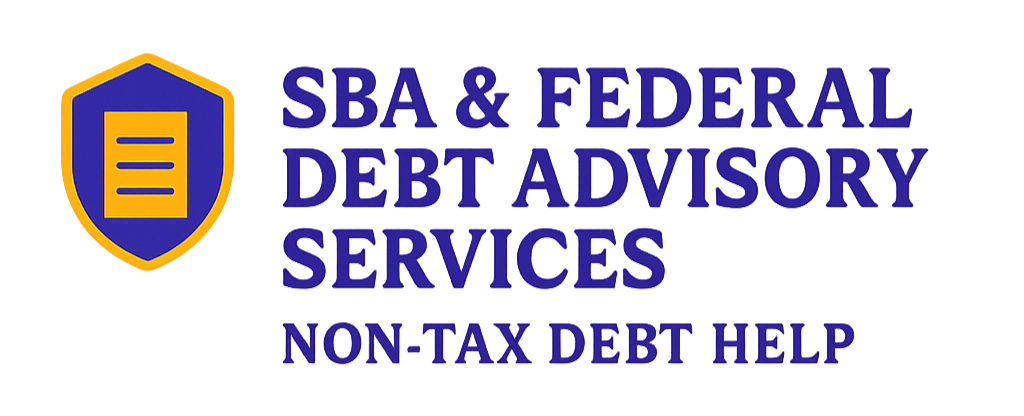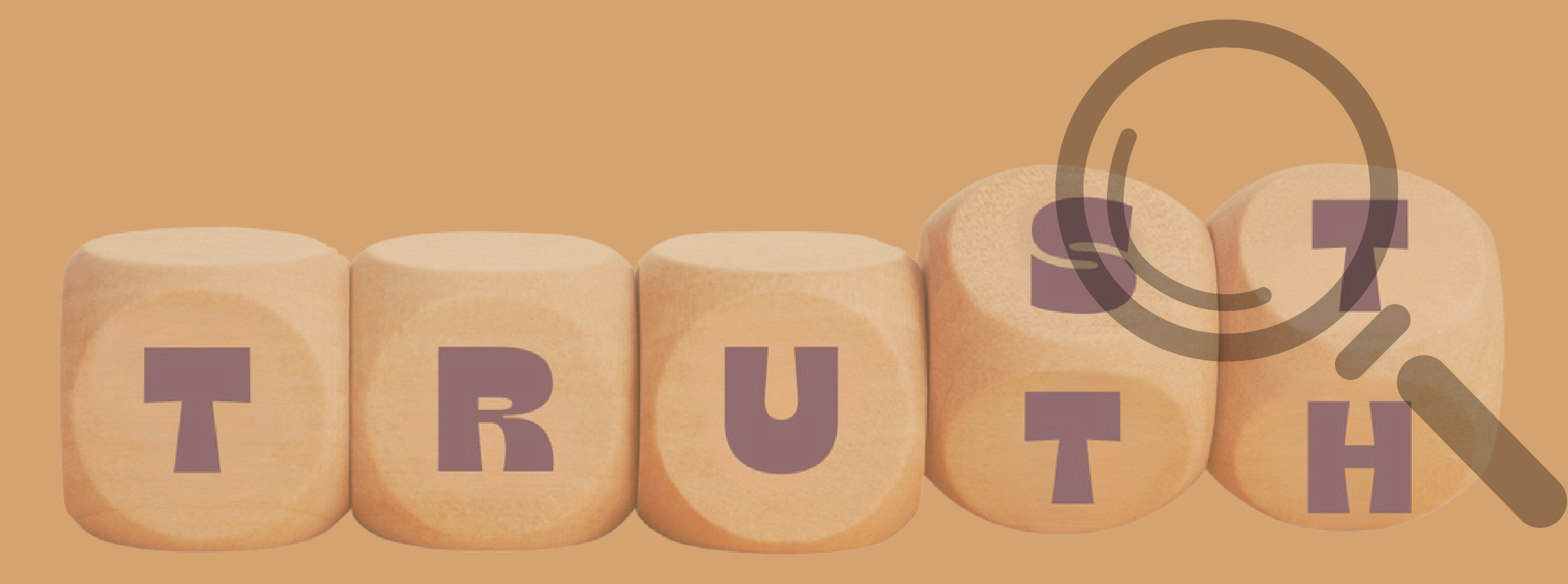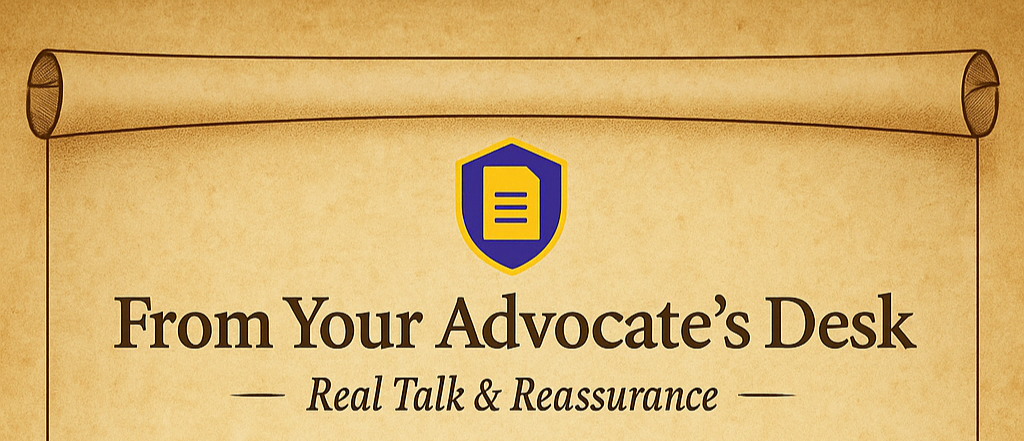
You didn’t set out to land in debt. You didn’t picture Treasury letters showing up in the mail. And you definitely didn’t expect to feel this kind of shame, frustration, or fear. But now you wake up with a pit in your stomach that doesn’t go away. You replay what happened, trying to figure out what you could have done differently. You feel stuck in a nightmare (one where your paycheck, your tax refund, even your peace of mind no longer feels safe). You may even be facing garnishment or a tax refund offset and you do not know what your rights are. You wonder if anyone really understands what you’re going through. You wonder if anyone understands what it’s like to deal with the Bureau of the Fiscal Service or feel powerless as federal debt collection moves forward without warning. If you’re here, reading this, you’re not alone. And your story is more common than you think.
This defaulted SBA Loan didn’t begin with recklessness. It began with a dream, a plan, and the courage to step into something bigger for your family, your community, and your future. Maybe you spent months researching your market, writing your business plan, and lining up support. Maybe you sat across from a loan officer and explained exactly how you were going to make it work. Maybe you opened a storefront, hired your first team member, or bought your first piece of equipment with pride.
You applied for that SBA loan or federal disaster assistance believing it was the right move. You had no idea it might be flagged for collection later by the Treasury Department. Some of you brought on a partner that is a friend, a spouse, or a relative because it felt safer not to build it alone. You shared the vision, the risk, and the responsibility. And for a while, it worked. You put in the early mornings, late nights, and weekends that no one saw. You missed birthdays, postponed vacations, and worked through holidays. Some of you didn’t take a paycheck for months (or even years) because there wasn’t enough left over.
You had the business. You had the loan maybe an SBA 7(a), SBA Express, or SBA CDC 504, or an EIDL, loan. You had the drive. What you didn’t have was a backup plan for what came next. Maybe it was the pandemic. Maybe your industry shifted overnight, or your supplier shut down, or the cost of goods tripled. Maybe you got sick, or someone you love did. Maybe your ability to earn was interrupted before you even realized you were headed toward non-tax federal debt. Maybe a natural disaster destroyed your inventory, your storefront, or your motivation. Maybe a partner pulled out and left you holding the debt, including a defaulted SBA loan now flagged for collection by the Bureau of the Fiscal Service. Some of you took out a second loan, maybe even against your home, trying to buy just a little more time. Some of you hired a consultant, hoping for a new idea that would plug the leaks. Some of you were playing Financial Whack-a-Mole. You solved one problem only to have two more pop back up. You searched for help paying back your SBA loan. You wondered if there was a way to avoid default on your SBA guaranteed loan. You kept looking for options. You weren’t giving up. You were giving it everything you had left. Even as interest compounded and federal notices started coming in, you tried to find a way forward before your SBA loan repayment problems became something you couldn’t undo. But the numbers stopped working, no matter how hard you worked. And that’s how good people end up in the crosshairs of wage garnishment, offsets, or collection by the Bureau of the Fiscal Service.
“Strength doesn’t always roar. Sometimes it quietly fills out the form, asks the question, and says, ‘I’m not done yet.’”
For example, some business owners took advantage of training and mentoring programs offered by organizations like SCORE or their local Small Business Development Center (SBDC). You may have joined a workshop to sharpen your skills before applying for a Small Business Administration loan — or reached out for guidance when your business began facing financial trouble. Maybe you worked closely with a mentor who helped you create a business plan, organize your finances, and present a solid loan package. You didn’t walk into that bank meeting unprepared. You showed up with a real vision and the tools to back it up. When payments started showing up late, your lender may have offered SBA loan restructuring, a payment deferment, or extended terms to help you stay afloat. But in spite of their help, and everything you tried, it still wasn’t enough to pull your business out of financial trouble. That doesn’t make you a failure. It makes you someone who showed up and gave it your all, even when the odds were stacked against you. And now, you deserve to understand what happens next.
No one takes out a Small Business Administration loan planning to default. You did not set this up to fail. You did not expect to miss payments, fall behind, or lose touch with your lender. You thought you would catch up. Maybe after the busy season, after that one big contract, after things calmed down. But it did not happen that way. The pressure built. Notices came. You called once, maybe twice, maybe more, but the answers never came. Or the wait times were too long. You had a business to run, and no one seemed to be on the other end. Eventually, the lender filed a claim with the Small Business Administration. The Small Business Administration paid out the guarantee and took over the debt. That didn’t mean the clock stopped ticking. It meant a new round of notices began. You may have received a demand letter or a formal warning that your loan was officially in default. You may have been given a short window to respond, appeal, or pay in full. And when the balance still was not resolved, your account was referred to the Bureau of the Fiscal Service, the federal agency entrusted with collecting non-tax debt. That transfer was not just paperwork. It meant your debt was now subject to garnishment, Treasury offset, and federal enforcement actions. You may have learned that the hard way: it started with a letter that made your stomach drop, then came a reduced paycheck or a tax refund that quietly disappeared before it ever hit your account. You did not ignore this on purpose. You were trying to survive. And no one gave you a playbook for what to do when your loan crossed that line. Now you need to know how to navigate Treasury debt collection, because understanding the process is the first step to taking back control.
You didn’t fail. You aren’t irresponsible. And you’re not the only one this has happened to. You took a risk to build something. You tried. You fought to keep it going. And now, you’re facing consequences that feel unfair, overwhelming, and confusing. You deserve more than silence. You deserve more than cold notices and clipped phone calls. You deserve answers. You deserve support. You deserve a real advocate in your corner who understands how Treasury debt collection works and can help you navigate what comes next. We’re not here to judge you. We’re here to guide you. If you’re ready to take the next step, we’re ready to walk you through it.
You’re Not the Only One:
According to Federal News Network, the Small Business Administration has referred over 1.6 million defaulted COVID-19 loans to the Treasury Department for collection — and they only expect to collect on about 40% of them.
That means over a million people just like you are trying to find their way forward.
This isn’t just your burden.
It’s part of a bigger picture — and you’re not the only one facing it.
Questions from Our Clients:
📌 Do I have to take a business course to get help with my SBA loan?No. Business training is not a requirement to receive or manage an SBA loan. While some organizations offer voluntary business courses to help entrepreneurs improve their skills, these programs are not part of the loan approval or collection process.
📌 Do I have to appear in person for a wage garnishment hearing?No. Most federal agencies, including the Bureau of the Fiscal Service, do not conduct in-person hearings. Some may allow a phone hearing if you request one, but most decisions are made through a records review process. You’ll typically submit your hearing request in writing. If you're challenging the debt, its balance, and/or claiming hardship, the agency will send you a packet that includes the debt details, a financial disclosure form, and a request for income and expense documentation. You’ll be given time to respond before the hearing official reviews your file and sends you a written decision.
📌 Does the IRS handle Small Business Administration loan offsets?No. While your IRS tax refund can be taken to repay a federal loan, the process is handled by the Treasury Offset Program through the Bureau of the Fiscal Service, not the IRS.
📬 Schedule your free 15-minute consultation
🌐 Learn more at www.NonTaxDebtHelp.com
Disclaimer: This resource is for informational purposes only and is not legal advice. SBA & Federal Debt Advisory Services is not a law firm and does not provide legal representation. We support individuals navigating federal debt processes as advocates and consultants. If your situation requires legal advice, you may wish to consult an attorney. This resource was created by SBA & Federal Debt Advisory Services. Learn more at NonTaxDebtHelp.com or schedule your free 15-minute consultation at: SBA & Federal Debt Advisory Services


 DisclaimerDisclaimer
DisclaimerDisclaimerLooking for more support and straight answers?
Check out these helpful posts:
Can the U.S. Bureau of the Fiscal Service Really Garnish My Wages?
From Your Advocate’s Desk – Real Talk & Reassurance

You didn’t set out to land in debt. You didn’t picture Treasury letters showing up in the mail. And you definitely didn’t expect to feel this kind of shame, frustration, or fear. But now you wake up with a pit in your stomach that doesn’t go away. You replay what happened, trying to figure out what you could have done differently. You feel stuck in a nightmare (one where your paycheck, your tax refund, even your peace of mind no longer feels safe). You may even be facing garnishment or a tax refund offset and you do not know what your rights are. You wonder if anyone really understands what you’re going through. You wonder if anyone understands what it’s like to deal with the Bureau of the Fiscal Service or feel powerless as federal debt collection moves forward without warning. If you’re here, reading this, you’re not alone. And your story is more common than you think.
This defaulted SBA Loan didn’t begin with recklessness. It began with a dream, a plan, and the courage to step into something bigger for your family, your community, and your future. Maybe you spent months researching your market, writing your business plan, and lining up support. Maybe you sat across from a loan officer and explained exactly how you were going to make it work. Maybe you opened a storefront, hired your first team member, or bought your first piece of equipment with pride.
You applied for that SBA loan or federal disaster assistance believing it was the right move. You had no idea it might be flagged for collection later by the Treasury Department. Some of you brought on a partner that is a friend, a spouse, or a relative because it felt safer not to build it alone. You shared the vision, the risk, and the responsibility. And for a while, it worked. You put in the early mornings, late nights, and weekends that no one saw. You missed birthdays, postponed vacations, and worked through holidays. Some of you didn’t take a paycheck for months (or even years) because there wasn’t enough left over.
You had the business. You had the loan maybe an SBA 7(a), SBA Express, or SBA CDC 504, or an EIDL, loan. You had the drive. What you didn’t have was a backup plan for what came next. Maybe it was the pandemic. Maybe your industry shifted overnight, or your supplier shut down, or the cost of goods tripled. Maybe you got sick, or someone you love did. Maybe your ability to earn was interrupted before you even realized you were headed toward non-tax federal debt. Maybe a natural disaster destroyed your inventory, your storefront, or your motivation. Maybe a partner pulled out and left you holding the debt, including a defaulted SBA loan now flagged for collection by the Bureau of the Fiscal Service. Some of you took out a second loan, maybe even against your home, trying to buy just a little more time. Some of you hired a consultant, hoping for a new idea that would plug the leaks. Some of you were playing Financial Whack-a-Mole. You solved one problem only to have two more pop back up. You searched for help paying back your SBA loan. You wondered if there was a way to avoid default on your SBA guaranteed loan. You kept looking for options. You weren’t giving up. You were giving it everything you had left. Even as interest compounded and federal notices started coming in, you tried to find a way forward before your SBA loan repayment problems became something you couldn’t undo. But the numbers stopped working, no matter how hard you worked. And that’s how good people end up in the crosshairs of wage garnishment, offsets, or collection by the Bureau of the Fiscal Service.
“Strength doesn’t always roar. Sometimes it quietly fills out the form, asks the question, and says, ‘I’m not done yet.’”
For example, some business owners took advantage of training and mentoring programs offered by organizations like SCORE or their local Small Business Development Center (SBDC). You may have joined a workshop to sharpen your skills before applying for a Small Business Administration loan — or reached out for guidance when your business began facing financial trouble. Maybe you worked closely with a mentor who helped you create a business plan, organize your finances, and present a solid loan package. You didn’t walk into that bank meeting unprepared. You showed up with a real vision and the tools to back it up. When payments started showing up late, your lender may have offered SBA loan restructuring, a payment deferment, or extended terms to help you stay afloat. But in spite of their help, and everything you tried, it still wasn’t enough to pull your business out of financial trouble. That doesn’t make you a failure. It makes you someone who showed up and gave it your all, even when the odds were stacked against you. And now, you deserve to understand what happens next.
No one takes out a Small Business Administration loan planning to default. You did not set this up to fail. You did not expect to miss payments, fall behind, or lose touch with your lender. You thought you would catch up. Maybe after the busy season, after that one big contract, after things calmed down. But it did not happen that way. The pressure built. Notices came. You called once, maybe twice, maybe more, but the answers never came. Or the wait times were too long. You had a business to run, and no one seemed to be on the other end. Eventually, the lender filed a claim with the Small Business Administration. The Small Business Administration paid out the guarantee and took over the debt. That didn’t mean the clock stopped ticking. It meant a new round of notices began. You may have received a demand letter or a formal warning that your loan was officially in default. You may have been given a short window to respond, appeal, or pay in full. And when the balance still was not resolved, your account was referred to the Bureau of the Fiscal Service, the federal agency entrusted with collecting non-tax debt. That transfer was not just paperwork. It meant your debt was now subject to garnishment, Treasury offset, and federal enforcement actions. You may have learned that the hard way: it started with a letter that made your stomach drop, then came a reduced paycheck or a tax refund that quietly disappeared before it ever hit your account. You did not ignore this on purpose. You were trying to survive. And no one gave you a playbook for what to do when your loan crossed that line. Now you need to know how to navigate Treasury debt collection, because understanding the process is the first step to taking back control.
You didn’t fail. You aren’t irresponsible. And you’re not the only one this has happened to. You took a risk to build something. You tried. You fought to keep it going. And now, you’re facing consequences that feel unfair, overwhelming, and confusing. You deserve more than silence. You deserve more than cold notices and clipped phone calls. You deserve answers. You deserve support. You deserve a real advocate in your corner who understands how Treasury debt collection works and can help you navigate what comes next. We’re not here to judge you. We’re here to guide you. If you’re ready to take the next step, we’re ready to walk you through it.
You’re Not the Only One:
According to Federal News Network, the Small Business Administration has referred over 1.6 million defaulted COVID-19 loans to the Treasury Department for collection — and they only expect to collect on about 40% of them.
That means over a million people just like you are trying to find their way forward.
This isn’t just your burden.
It’s part of a bigger picture — and you’re not the only one facing it.
Questions from Our Clients:
📌 Do I have to take a business course to get help with my SBA loan?No. Business training is not a requirement to receive or manage an SBA loan. While some organizations offer voluntary business courses to help entrepreneurs improve their skills, these programs are not part of the loan approval or collection process.
📌 Do I have to appear in person for a wage garnishment hearing?No. Most federal agencies, including the Bureau of the Fiscal Service, do not conduct in-person hearings. Some may allow a phone hearing if you request one, but most decisions are made through a records review process. You’ll typically submit your hearing request in writing. If you're challenging the debt, its balance, and/or claiming hardship, the agency will send you a packet that includes the debt details, a financial disclosure form, and a request for income and expense documentation. You’ll be given time to respond before the hearing official reviews your file and sends you a written decision.
📌 Does the IRS handle Small Business Administration loan offsets?No. While your IRS tax refund can be taken to repay a federal loan, the process is handled by the Treasury Offset Program through the Bureau of the Fiscal Service, not the IRS.
📬 Schedule your free 15-minute consultation
🌐 Learn more at www.NonTaxDebtHelp.com
Disclaimer: This resource is for informational purposes only and is not legal advice. SBA & Federal Debt Advisory Services is not a law firm and does not provide legal representation. We support individuals navigating federal debt processes as advocates and consultants. If your situation requires legal advice, you may wish to consult an attorney. This resource was created by SBA & Federal Debt Advisory Services.
